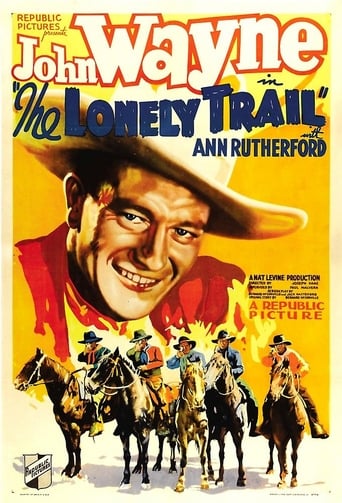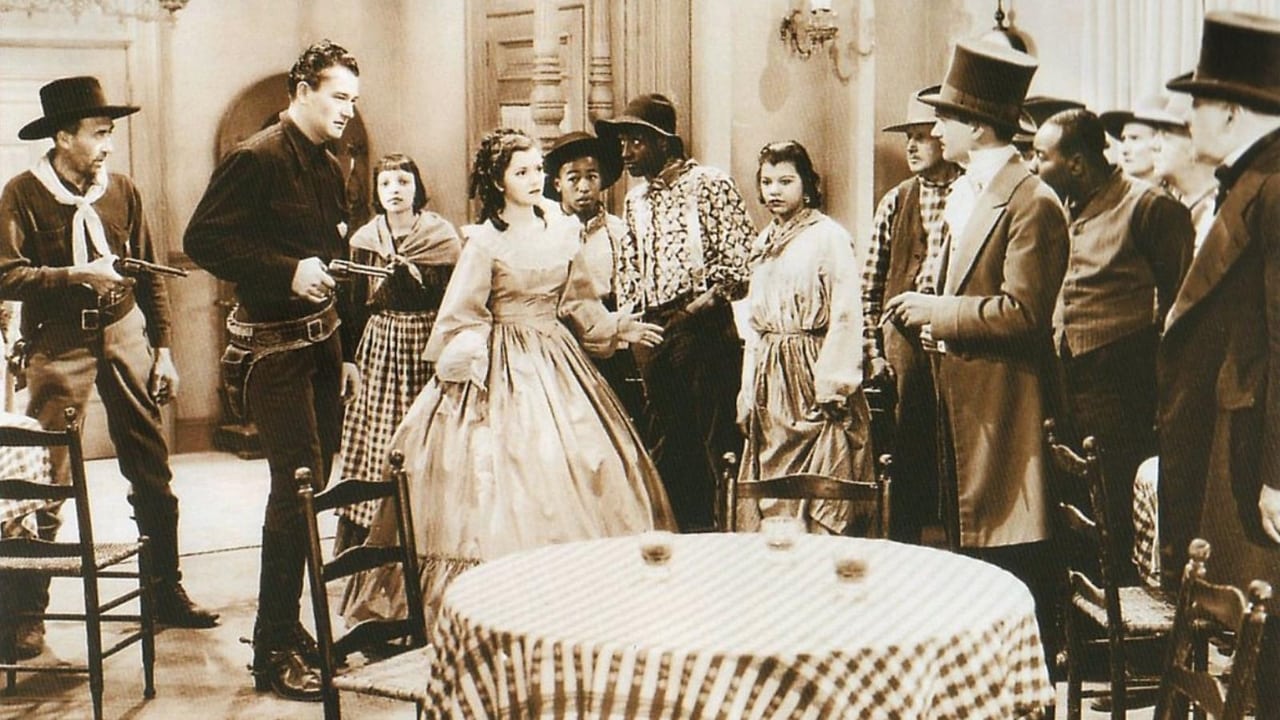JohnHowardReid
Much of interest in this western including a night-time climax with our heroes fighting the villains in silhouette and insurgents carrying torches dynamiting the gates of the fort. Wayne and his sidekick Toney (called "Tony" in the credits, but then Etta McDaniel is given an "s" in her surname so the official spelling is none too reliable) make a late entrance, after a montage of spectacular Civil War stock footage and a lot of material in which the heavies led by Cy Kendall (love his broad-brimmed hats) establish their oppression. The bad guys as usual have it all over the goodies in charisma. Wayne is pleasant enough, but squawky-voiced Rutherford is a pain and Mr Meadows/Moore is bland to the point of somnambulism. As for Mr Toones, we will pass over his stereotype in silence. Yes, give us dyed-in-brutality Bob Kortman and his naive but willing henchman Yakima Canutt any day. The one thing the nice folks have going for them is an ingenious series of musical look-outs, featuring Stephen Foster's "Camptown Races". Another pleasant musical device has a fine choir singing "Swing Low, Sweet Chariot" as the faithful retainers stage a mock funeral.A rather extensive support cast list has been provided for this one by Republic's publicity boys, but why no credit for Charles King as the sentry? And isn't that Lafe McKee in a cameo part as the father prisoner?For all the threats and on-camera opportunism, there is not a great deal of gutsy action in this one. Even the climax is resolved with disappointing rapidity. The presence of Yakima Canutt in the cast often guarantees thrilling stuntwork, but even that is limited to a couple of falls and a good leap from horseback on to a fleeing buckboard. Joseph Kane has directed this chase with some welcome running inserts, and has generally handled the film competently, making fair use of his Lone Pine locations. (That is Mount Whitney you can see in a couple of backgrounds, even though this is supposed to be set in Texas).Incidentally, former stuntman turned producer Paul Malvern was a crack shot. He and Wayne insisted on actually shooting the dipper out of Duke's hand. Kane refused to direct such an "idiotic" stunt, so Malvern himself took over for this one shot. (Actually it required two. The first shot hit the dipper all right, but failed to knock it out of Wayne's hand).
MartinHafer
Early in his career, John Wayne was a very, very busy man--working in a long string of B-Westerns throughout the 1930s. While all of them are reasonably good, they are so short and so similar that I just can't bring myself to watch them all (and there were MANY). They're not bad, mind you, but they also aren't all that memorable. It seems that when this Wayne film came on TCM I wasn't very busy so I decided to watch--and this is exactly what this film is--a decent time-passer.As the film begins, you can see that this film is influenced by the BIRTH OF A NATION myth concerning the Reconstruction period. According to this myth, the good Souterners were taken advantage of by evil Northern opportunists bent on robbing the Southerners blind and taking away all their freedom. While it is true that there was, for a while, martial law in the Southern states following the Civil War, the truth is that Reconstruction didn't go far enough--soon allowing the old Southern power structure to return and forcing the Blacks back into subservience.While this film is not so offensive and over the top as BIRTH OF A NATION (where all the Blacks were raping idiots), in this film they are portrayed as happy with the status quo and liked their old slave owners. This "happy ex-slave" portrayal is rather insulting and I'm sure it will raise a few eyebrows in many viewers! Fortunately, 21 years had passed since BIRTH OF A NATION and so in addition to showing Black Americans a little more sympathetically, they also ultimately revealed that not ALL the Northerners were evil Carpetbaggers! If you are looking for an accurate history lesson, this is certainly not the film to see! Now as for the rest of the film, Wayne is in excellent form--showing some improvement in his acting skills since earlier films (which were VERY rough). He still wasn't exactly the John Wayne of the 40s and 50s in style, but he was getting close. The plot is also pretty exciting and very watchable--much like a Gene Autry film (but without the cars and phones you might see in an Autry film).Overall, this is very much a 1930s kids' film that is modest in its pretenses but still entertaining and watchable. For die-hard fans of the Duke, it's probably a must-see. For others, it's just a run of the mill 30s Western.
estabansmythe
The Lone Star and early Repulic two-reeler "oaters," i.e., hour-long westerns, ably served as John Wayne's training ground throughout the Thirties. I think most of the Duke's 1933-39 oaters entertaining as hell.The cast, writers and production crew get in, get it done and get out, all in an hour give or take a few minutes. And they usually did it well. Were they corny? You bet, pardner. We're they sappy? At times. We're they scrappy? You bet yer boots! It was in these films that Wayne and actor/stuntman extraordinaire Yakima Canutt developed the draw-back punch that's become the standard in film fights ever since. The Lonely Trail, an early Republic feature from it's first year, 1936, is involving and action-packed and loaded with classic early western character actors of the era, such as Cy Kendall, Sam Flint and the legendary Canutt. It was directed by the king of '30s B westerns, Joe Kane and also featured a young Ann Rutherford "Snowflake." These are not up there with the great films of the era, not even close. However, for fans of the genre, they are a most entertaining way to spend an hour.
Single-Black-Male
Although I am a John Wayne fan, this film was painful to watch. Which begs the question, did John Ford bring something to John Wayne's career that he didn't possess before they worked together? I would say that they both needed each other. The John Ford films without John Wayne weren't that good, and the westerns that John Wayne appeared in like this one (which were not directed by John Ford) were just as bad. So what exactly did John Wayne lack in this film? I think the non-John Ford directed John Wayne westerns lacked a story, emotional depth, colour, scenery and a bit of spectacle. Before the John Ford/Wayne collaboration, westerns were just some B picture, but what John Ford did was to give it spectacle like the Cecil B. DeMille films.



 AD
AD



